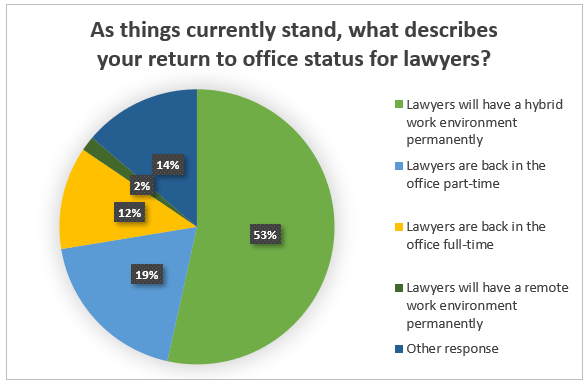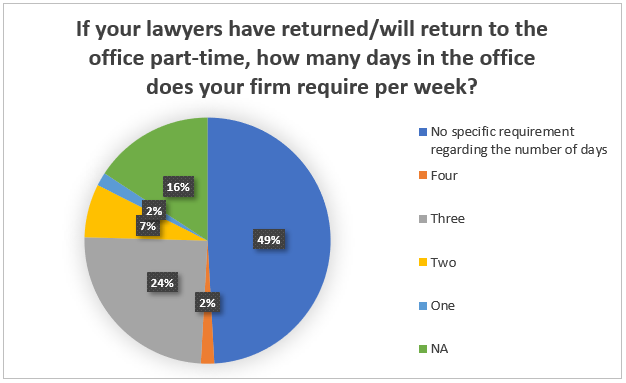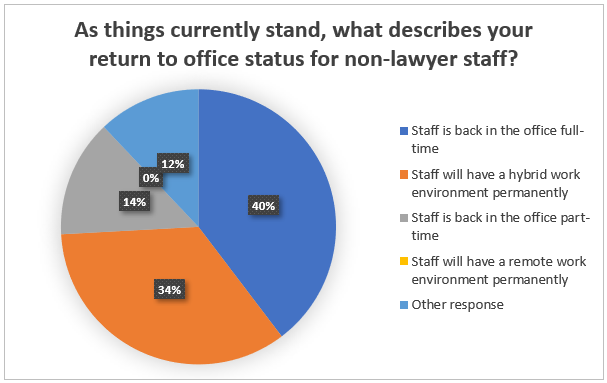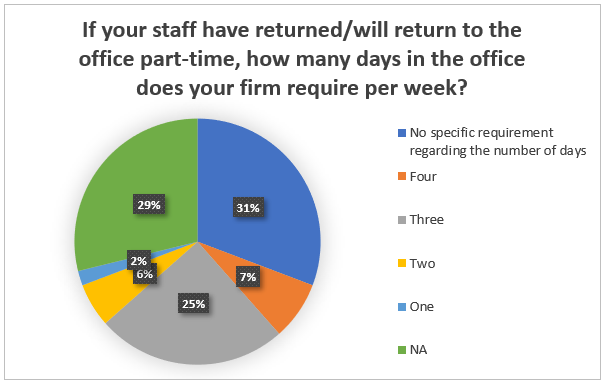Lawyers have the tendency to argue just about any topic, and today’s topic is remote and hybrid work. During the height of the pandemic, many firms were forced to go fully remote; however, as we move into the post-COVID era, there has been a significant tug-of-war between returning to the office or remaining remote.
Those who advocate for a return to the office wish to go back to the way things were – arguing in-person work creates culture, trains staff and allows leaders to lead. Those who advocate for hybrid work arrangements argue that is all true, but it does not have to be a five-day-a-week requirement. Remote advocates, among other benefits, believe remote work reduces commuting time, which lessens the firm’s impact on the environment, and if true, law firms can not only become more family-friendly but also reduce their environmental impact.
The environmental impact of remote work can be calculated using a few core assumptions:
- 10 employees working a standard five days a week, 48 weeks a year and commuting 30 miles each way when they work in-office;
- Wearing dress clothing to the office; and
- Home office equipment uses extra electricity.
Fast Stats
A recent Withum survey of American law firms revealed the reality of return-to-work plans across the country.




Before COVID, 80% of New York City employees used some form of mass transit to get to the office five days a week (Table 1). Employees going to suburban offices drive each day (Table 2). Assuming the above is true, a 10-person NYC law office would generate 11 metric tons (mt) of CO2e per year. On the other hand, an office located in the suburbs would generate 50 mt of CO2e.
Table 1: 80% Use Mass Transit
| Pre-COVID mt C02e |
3 Days mt C02e |
1 Day mt C02e |
|
|---|---|---|---|
| Mass Transit | 11.4 | 6.8 | 2.3 |
| Driving | 9.6 | 5.8 | 1.9 |
| Dry Cleaning | 1.3 | 0.8 | 0.3 |
| Office Equipment | 0.0 | 0.3 | 0.6 |
| 11.0 | 6.9 | 2.8 |
Table 2: Everyone Drives
| Pre-COVID mt C02e |
3 Days mt C02e |
1 Day mt C02e |
|
|---|---|---|---|
| Mass Transit | 0.0 | 0.0 | 0.0 |
| Driving | 48.1 | 28.9 | 9.6 |
| Dry Cleaning | 1.3 | 0.8 | 0.3 |
| Office Equipment | 0.0 | 0.3 | 0.6 |
| 49.5 | 30.0 | 10.5 |
Now assume all facts remain the same except employees work two days a week remotely. Adjusting for the added home electrical usage and reduction in dry cleaning, we calculate a reduction of 4 mt of CO2e for an NYC office and 20 mt of CO2e for a suburban office. So, what we find is that remote work has a significant impact on the suburban office’s emissions and a minor impact on the NYC office.
QUICK FACT
It takes 60 acres of U.S. forests one year to sequester enough CO2 to eliminate the carbon impact from 50 mt of C02e.
If all things remained the same, we could stop here. However, post-COVID, employees changed their commuting habits and stopped using mass transit. In this scenario, an NYC office now resembles a suburban office’s emissions profile. Pre-COVID, an NYC office generated 11 mt of CO2e, and post-COVID, an NYC office with a three-day-a-week in-person work schedule will generate 30 mt of CO2e. Beyond avoiding city crime and pollution, a significant reason for this change is that commuting a few days a week makes the higher cost of driving more palatable versus the cost of using mass transit, such as train travel, five days a week.
Conclusion
For a suburban office, remote work has had a positive impact on the environment by helping lower emissions. For an NYC office, the story is more complicated. If NYC office commuters continued to use mass transit, remote work would have little environmental impact. However, when an NYC firm offers hybrid work arrangements, the cost of driving to the office becomes justifiable and more people choose driving over mass transit. Therefore, counter to common perception, hybrid work arrangements in large cities such as New York can create a spike in emissions due to employees’ changed commuting behavior. Without incentivizing mass transit, hybrid work has paradoxically spurred a larger environmental footprint from NYC commuters.
Contact Us
Employers: You can make a direct impact on emissions in mass-transit-friendly cities like NYC by promoting mass transit. Reach out today to estimate your influence and tell your ESG story.




